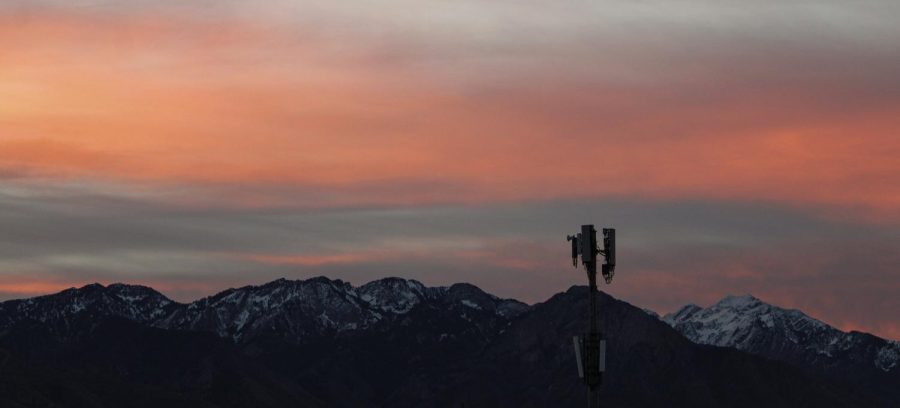Shadley: The Times Are Changing, so Let’s Stop Changing Them Twice a Year
The sun rises over mountains in Salt Lake City on Friday, Nov. 13, 2021. (Photo by Brooklyn Critchley | The Daily Utah Chronicle)
November 18, 2021
Earlier this month we all participated in the archaic tradition of setting our clocks back an hour. We spend a few days joking about the time change, venting about how “it gets dark so early now” and trying to relearn how to set our oven clock, but soon we forget about it. To anyone who’s grown up in America (outside of Hawaii and Arizona), our biannual time change is, well, normal. But should it be?
Benjamin Franklin first introduced the idea of Daylight Saving Time (DST) (And, it is “Saving,” not “Savings.”) in 1784 so that people could save money on candles. As ridiculous as that may sound in 2021, we do save money on “candles.”
After a 2005 decision to extend DST by four weeks (beginning in 2007), the U.S. Department of Energy found that we saved half a percent of electricity daily. While that may be a reason to prefer permanent DST over permanent standard time, that doesn’t justify our repeated switching back and forth. That practice is primarily justified by the Standard Time Act of 1918, which put every U.S. state on standard time, with the ability to opt into the biannual switch to DST.
The Utah State Legislature passed a bipartisan bill in the 2020 session that would put Utah on permanent DST, with the hope that federal legislation would amend the Standard Time Act. Eighteen other states have done the same.
The only reason we continue a practice that, if canceled would drastically reduce rates of sexual assault, robbery and health complications, is because it’s the way we have always done things. The U.S. allowing states to opt for permanent DST would come with many benefits, but most importantly, it would signal a shift away from the unwarranted American reverence for tradition. Just because we have always done something a certain way does not mean that is the best way to do it.
Permanent Standard Time vs. Permanent DST vs. Status Quo
As a country, we have three options. First, we can continue changing our clocks twice a year, an act that leads to forced sleep deprivation each year. On the day after we lose an hour of sleep, hospitals report a 24% spike in heart attack visits and there is a significant increase in fatal car accidents in the week after the switch. This completely unnecessary loss of life for arbitrary reasons must stop.
Our second option, then, is to switch to permanent standard time. Only Arizona and Hawaii have chosen to do so. Hawaii is a special case where, because of their proximity to the equator, their sunrise and sunset times don’t change much throughout the year. In a state with 144 days a year that reach 100 degrees, the desire to minimize daylight in Arizona is so remarkably understandable. However, all 48 other states choose to undergo the practice of switching clocks so that they can enjoy the benefits of DST for at least part of the year.
The third and final option is the adoption of permanent DST. Again, this would require the federal government to pass a bill, like the bipartisan Sunshine Protection Act of 2021, allowing states to opt for permanent DST. That bill, importantly, allows states like Arizona, which deem standard time to be more beneficial for them, to remain on permanent standard time.
Benefits of DST
For the entire month of December, Salt Lake City’s sunset happens at roughly 5 p.m., right around the time most people are getting out of work. Our arbitrary adoption of standard time during this month causes people to walk home, or walk to their car, in the dark, where they’re more susceptible to assault. If you get out of class or work at 5, why should you have to take that unnecessary risk?
Instead, permanent DST would make the earliest sunsets happen at 6:00 p.m. After the switch to DST in the spring, researchers at Stanford found a decrease in rates of robbery by 51%, rape by 56% and murder by 48% during that extra hour of sunlight.
The easiest thing we can do to make everyone’s commute safer is an extra hour of daylight. That extra hour also gives people more time to recreate outside in the sun, which has multiple mental and physical health benefits.
There are numerous benefits to permanent DST, and that’s why 48 states endure our dated tradition of changing the clocks twice a year to receive them. Yet, because of a law enacted over a century ago, those states are unable to make that switch for themselves.
However, permanent DST realistically has marginal effects on most people’s lives, and there are certainly more pressing issues. So, why does it really matter if we get rid of this quirky time change thing we do? Well, so many of the issues surrounding income inequality, climate inaction and social justice occur, to some extent, because of this same refusal to reevaluate hundred-year-old traditions.
If we’re ever going to create a truly equitable society, it requires our government to adapt to modern times. An arbitrary, hundred-year-old law about time zones is an easy way to demonstrate we’re able to do that. And we’ll save some candles in the process.









